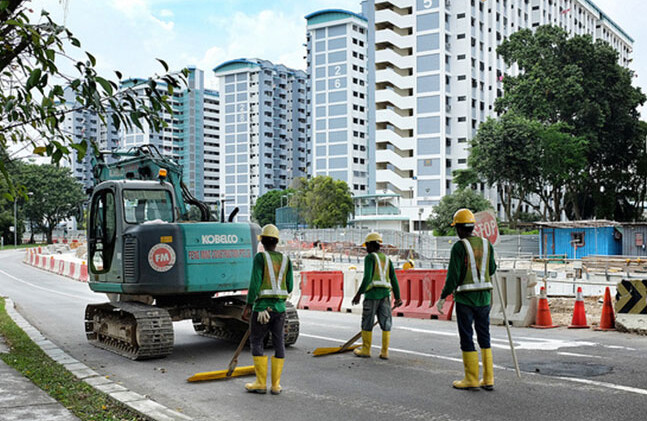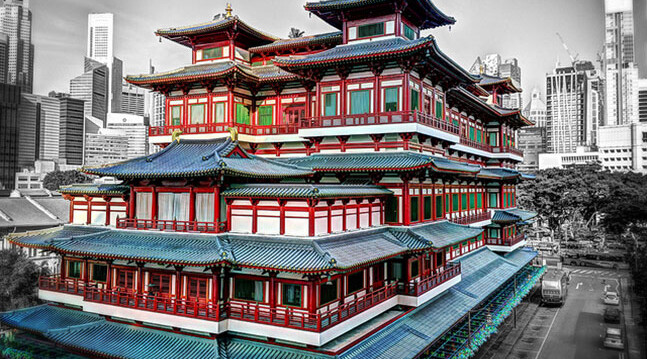In Tuas View, an industrial neighborhood in Singapore, migrant workers have little reason to leave their buildings. They live in a 15,000 square foot dormitory, where they enjoy fitness centers, movie theaters, food courts, and even a beer garden. To the west, there is a balcony that offers a beautiful view of the Johor Strait, and shuttle services bring them to and from their work sites. More than 50,000 migrant workers call it home, and there is room for 60,000 more. The best part? Their employers pay for everything.
Take a closer look, however, and a darker reality emerges. Upon arrival and departure, each inmate is fingerprinted and time-stamped, data that is then routed to their employer. Internally, more than 250 CCTV cameras monitor their every movement. When they do leave, they will find themselves tucked away far from the residential areas where native Singaporeans live. Indeed, the locals' attitude toward migrants is a familiar one: let them come, but not into my neighborhood.
Singapore is one of the world's biggest net importers of migrant labor, which the Ministry of Manpower sorts into three categories: unskilled, semi-skilled, and skilled. The latter are highly sought after, and impressive overtures have been made to attract as many as possible. So far, they have been successful: the Ministry of Education's efforts to rebrand itself as an English-speaking "global schoolhouse" has made Singapore an attractive place for skilled labor, both fledgling and established. American billionaire and investor Jim Rogers recently gained attention for his move to Singapore, claiming that "In 1807, if you had moved to London, you would have done a very brilliant thing...in 1907, if you moved to New York...and in 2007, if you move to Asia, that is a very smart thing to do."
Because Singapore has no natural resources, its economy is primarily knowledge-based, making skilled laborers very valuable. Yet supporting its rapidly growing economy requires investment in infrastructure projects such as construction, manufacturing, and shipyard work. Unskilled migrant workers, most of whom come from Bangladesh, Nepal, and other poor South Asian countries and who will hereafter be referred to simply as "migrant workers,"1 have come to form the backbone of these industries. In 2015, the number of such nonresidents working in Singapore was more than 870,000, out of a total population of 5.5 million. Because these migrant workers are not given basic labor protections such as a minimum wage, standardized working hours, and a right to unionize, the firms employing them are able to save money on labor costs. This has helped Singapore's infrastructure keep pace with its economic growth, reinforcing its status as one of the richest countries in the world.
However, the international community has raised concerns that the country has dehumanized these workers, even though many still live comfortable lives in places like Tuas View. Ever since the 2013 death of a migrant worker sparked a riot in the Singaporean ethnoburb of Little India, the government has kept a close watch over its migrant population, especially those who perform unskilled labor. Purpose-built dormitories like the one described above, which are subsidized by the government and built by the private sector, became very popular after the riot, and many migrant workers now call them home. Businesses benefit because tenants are accommodated in the most efficient way possible, making their rent very cheap: housing per worker, on average, costs employers $200 per month, compared to the $500 average for ordinary housing. The government benefits because migrant workers become organized into easily-manageable units, hidden from a native population that considers their presence bad for their community.
This prompts a challenging and increasingly relevant ethical question: To what extent should the provision of basic needs substitute for robust civil rights? Syrian refugees in Turkey, for example, are treated exceptionally well relative to those of other Middle Eastern host countries: each of the country's 24 refugee camps provides satellite television and air conditioning, in addition to basic food allowances and shelter. However, because the Turkish government does not legally recognize them as refugees, their privileges are not protected by international law. Similarly, migrant workers in Singapore enjoy free housing, accessible entertainment, and reliable sustenance, but are embedded in a legal and social complex of surveillance and segregation, such that "the private living space of the migrant workers becomes a landscape of surveillance and power."2
To be fair, the Singaporean government has recently prioritized the rights of migrant workers, resulting in a few progressive reforms. One of the central legal instruments governing the treatment of migrant workers in Singapore, the Employment of Foreign Manpower Act, was revised in 2007 to include the mandate for employers to provide free housing. The Foreign Employees Dormitories Bill, passed in early 2015, requires housing units containing more than 1,000 workers to observe stricter regulations in safety, psychosocial activity, and space requirements (smaller housing units are not subject to the regulations). The Singaporean Ministry of Manpower also performs regular inspections in migrant housing units, and can levy huge fines on employers who fail to secure the safety of their workers.
Furthermore, other countries have far worse human rights records regarding their treatment of foreign workers. Many are aware of the recent Qatari abuses of foreign workers enlisted for construction in preparation for the 2020 Olympics, as a result of which more than 1,200 workers died. Saudi Arabia has initiated several deportation and detention campaigns targeting foreign workers within its borders. Russia has failed to pay more than 700 workers for the 2012 Winter Olympics in Sochi and has reportedly confiscated passports. Far-right candidates and parties in Western Europe and the United States, tapping into their countries' xenophobic tendencies, have constructed widely successful campaign platforms based on scapegoating migrant populations. Comparatively, Singapore seems remarkably humane, and critics seem needlessly indignant.
Nevertheless, there is a huge disparity between what is given to migrant workers and what is owed. Singapore is one of the richest countries in Southeast Asia. It hasa higher per-capita GDP than the United States, and the third largest ratio of millionaires per capita in the world behind Switzerland and Qatar. This prosperity is due in no small measure to the migrant workers, whom employers can compensate less for their labor. In addition, Singapore, like many rich countries, has experienced a sharp decline in its birth rate, resulting in a shortage of workers, especially in industries that natives consider beneath them. Together, these factors create an essential need, the solution to which Singapore is forced to outsource. This makes the migrant population integral to Singaporean prosperity.
Yet while Singaporeans become increasingly prosperous, migrant workers have yet to secure the right to unionize, making it difficult for them secure their already precarious employment conditions. In fact, employers have the unilateral right to cancel work visas, forcing repatriation. This makes any attempt at collective bargaining a very risky measure. Furthermore, because they are obligated to pay for their own workplace training, many migrant workers arrive in Singapore having already accumulated substantial debt. According to a 2012 report by Transient Workers Count Too (TWC2), a Singaporean non-profit specializing in migrant workers' rights, first-time Bangladeshi migrants arrived in Singapore with an average of $7,256 in debt incurred to pay for this training. With an average daily compensation of $18, this sum can take more than a year and a half to pay back.
The process by which foreign workers seek redress for workplace injury has also been subject to criticism. While the Singaporean Ministry of Manpower reports that workplace injuries in migrant-heavy industries such as construction were on the rise between 2010 and 2014, TWC2 reports that the average time it takes for workers to receive compensation for these injuries is approximately three to six months, during which time they are unable to receive any economic benefits from the government. Employers then have access to a number of means of either reducing or denying this compensation entirely: many employ in-house physicians who will intentionally downplay the severity of the injury, thus reducing costs.
Singapore's migration policies send a clear message to the workers themselves and to the watchful eyes of the international community: migrant workers will be treated well, but these benefits are the government's to give or take away. They are not based on any notion of inviolable rights, but on the sovereign generosity of the state. Although the government legally requires firms to provide housing for unskilled migrants, the lack of enforcing international norms means that the government retains the right to withhold them without any repercussions. In turn, this means that migrant workers do not have any recourse to rights when it comes to demanding better treatment. There are echoes of Ancient Rome: Caesar Augustus may have given the Romans elaborate carnivals and distributed bread in the streets, but the people did not have the right to demand a single morsel.
Yet perhaps condemning Singapore too harshly is unwarranted, even misguided. The host state certainly plays a crucial role in shaping the destiny of its migrant workers, but the state itself is operating in a globalized world, which is still a kind of "wild west" of human rights. In a world where borders are increasingly rendered meaningless by the interaction of markets and the people who are bound to them, many will find themselves holding legal citizenship in one country while spending the majority of their time working and living in another. In proportion that the size of the diaspora or diasporas of such people becomes larger in a country, the more the legal concept of citizenship becomes an expression of class rather than rights. Instead, a pernicious dyad now divides the population of most countries: citizen and noncitizen, creating, in turn, two corresponding sets of rules and standards that differ widely in what they empower people to do.
Addressing the vacuum that globalization has left in citizenship requires bold and novel thinking. Some policies, like the European Union's Schengen Area, which guarantees freedom of movement between participating member states such as Germany, France, and Italy, ensure a set of common labor standards among citizens from each state, even as they move from one country to another. While these standards apply only to citizens from Schengen states, it can be considered a logical extension and successful regional response to years of economic interdependence. Many will point out, and rightly so, that Schengen is the flower of many decades of European co-operation, brought about by both shared goals and shared trauma. There is simply no analogue that can bind together Southeast Asia, much less the world. Yet the Schengen zone provides a valuable precedent for thinking through new forms of humane borderlessness that have global durability, and which admit to less abuse than do current outdated assumptions about the responsibilities of the state.
NOTES 1 It should also be noted that migrant domestic workers in Singapore—classified as semi-skilled—lack many of the same protections as unskilled migrant workers, such as employment benefits, a minimum wage, and standardized working hours. Furthermore, because most work in private, domestic spaces, there is little to no government oversight over their relations with their employer, making the potential for abuse high. 2 Ye, Junjia (1992). Migrant Landscapes: A Spatial Analysis of South Asian Male Migrants in Singapore. In Hamzah Muzaini, Choon Piew-Pow (Eds.), Changing Landscapes of Singapore: Old Tensions, New Discoveries (142–154). Singapore: Nus Press.


